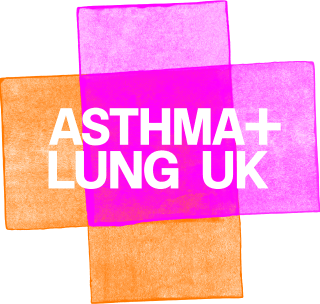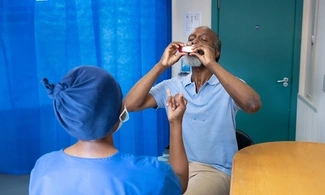Child asthma action plan
A child asthma action plan will help you and your child to manage their asthma. You can download a child asthma plan for free.
If your child is over 12 years old, they may want to use an adult asthma action plan. We have different plans available depending on the inhalers you use. We also have plans available in other languages.
My child’s asthma symptoms
Some of the symptoms your child might have are:
- wheezing
- coughing
- feeling short of breath
- a tight chest.
When to speak to your GP
Speak to your GP if your child:
- needs to use their reliever inhaler three or more times a week
- wakes up at night coughing or wheezing
- struggles to do exercise
- needs time off school or nursery because of their asthma.
Your child’s individual asthma signs
We know from parents and carers that children can display different behaviours when they get asthma symptoms. For example, they might become:
• quiet
• worried
• angry
• nervous
• frightened
• distracted
• clingy.
Your child might also:
• complain of a tummy ache
• lose their appetite
• say their ribs ache
• seem more tired than normal
• breathe faster or more shallow
• breathe differently, for example using their neck muscles
• be unable to talk or complete sentences.
When to call 999
Call 999 if your child’s reliever inhaler is not helping their symptoms, if they do not have their reliever inhaler, or if you’re worried at any time.
How can I manage my child’s asthma?
Use an asthma action plan
Our child asthma action plan is a leaflet that has all the information you need to look after your child’s asthma well. Find out more about asthma action plans for children.
Make sure your child takes their medicines
Your child will usually have a preventer inhaler and a reliever inhaler. Make sure:
• they take their preventer inhaler every day as prescribed.
• your child always has their reliever inhaler with them.
• your child uses a spacer if their inhaler is a pMDI (pressurised metered dose inhaler).
Find out more about your child’s asthma medicines. If your child has been diagnosed with severe asthma, they might have a slightly different treatment. Find out more about caring for a child with severe asthma.
Check your child’s inhaler technique
Your child’s GP or nurse will check your child’s inhaler technique at their yearly asthma review. But you can also make sure their inhaler technique is correct day-to-day. Our inhaler technique videos can help you.
Monitor your child’s symptoms
It can be helpful to monitor your child’s asthma symptoms over time to work out what their triggers might be, or if their asthma is getting worse.
Your GP or nurse may ask you to track your child's peak flow scores over time. This helps show if their medicine is working. You can use our peak flow diary to help you.
Coughing and wheezing
Coughing and wheezing are common in babies and young children. Children don’t always cough and wheeze because of asthma. Coughing or wheezing is more likely to be asthma if they have other asthma symptoms at the same time. They might also have no symptoms between these episodes.
Find out more about cough and wheeze in children.
Help your child stay fit and healthy
- Support your child to keep active. Exercise is good for your child when their asthma is well managed.
- Support your child to eat healthfully. Staying a healthy weight can help your child’s asthma symptoms.
- If you smoke, don’t smoke around children. Breathing in smoke will put your child at higher risk of having an asthma attack or make their symptoms worse .
Talking to my child about asthma
“Talking to your child about their asthma, even when they’re young, can help them understand what asthma is, why they might get symptoms like coughing and wheezing, and how their asthma medicines can help them. It can also help them to know signs of an asthma attack,” says Asthma + Lung UK nurse, Debby Waddell.
Simple ways to explain asthma to your child
You could try explaining asthma in a simple way to your child by using our example conversation starters:
- Lots of people have asthma. It means you might cough and wheeze sometimes, find it harder to breathe or feel like your chest is tight.
- You need to take your asthma preventer medicines every day to look after your asthma.
- Asthma doesn’t go away, but you can live well with it by taking your medicines.
- People can’t catch asthma from you. It’s not like a cold or flu.
- Some things might make your asthma symptoms worse, like dust.
- Your medicines help you with your symptoms.
- Tell me or your teacher if you feel unwell with your asthma.
- An asthma attack is where your symptoms get bad quickly, and you might feel like you can’t breathe.
Parents and carers of young children have told us they find it helpful to use a prop when talking to their child about asthma. For example, you could pretend a teddy or doll has asthma, and talk about how it might feel.
Help your child to look after their asthma
Young children can start to do small things to look after their asthma. For example, they could:
- help you wash their spacer
- choose a good place to keep their preventer inhaler and asthma action plan
- decorate a bag or pencil case to keep their reliever inhaler in.
If your child starts having asthma symptoms at school, or while they’re being looked after by someone else, they need to know it’s important to ask for help. Make sure they know they must tell someone straight away if they start to feel unwell.
When your child is older, you may find our information about asthma and young people useful.
Parents and carer support
Join our parent and carer support network. It’s a free support network for parents and carers of children with asthma. The events are held online on Zoom every month. Each meeting has a different topic and is organised by healthcare professionals.

Get support
Our helpline is closed from 1pm on Wednesday 24th December 2025 and re-opens at 9:15am on Friday January 2nd 2026. Our supporter care line is also unavailable during this period. If you have a flare-up of your lung condition symptoms, contact your GP or healthcare professional or 111 for advice. Always dial 999 in an emergency.








